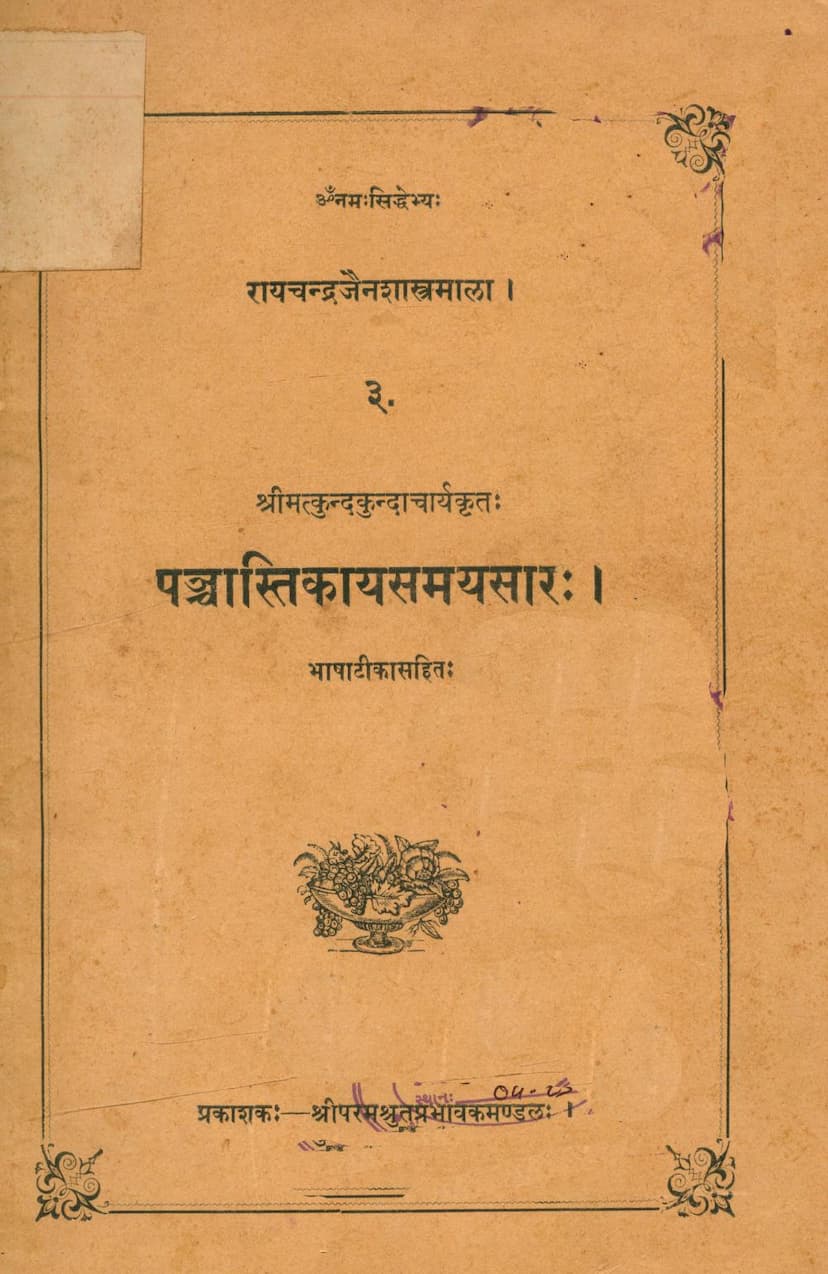Panchastikay Samaysar
Added to library: September 2, 2025

Summary
Here's a comprehensive summary of the Jain text "Panchastikay Samaysar" based on the provided pages, focusing on the essence of the text and the context of its publication:
Panchastikay Samaysar: A Summary of Jain Philosophy
"Panchastikay Samaysar," authored by the revered Kundkundacharya and translated and commented upon by Pannalal Bakliwal, with a foreword by Shrimad Rajchandra, is a foundational text in Jain philosophy. Published by Paramshrut Prabhavak Mandal, this work delves into the core principles of Jainism, offering a profound understanding of reality as perceived through the Jain lens.
The Essence of Reality: The Six Dravyas and Five Astikayas
The central theme of "Panchastikay Samaysar" revolves around the Jain concept of dravya (substance) and astikaya (that which has many parts or exists as a collection). Jain philosophy posits the existence of six eternal, uncreated, and indestructible substances that form the fabric of the universe:
- Jiva (Soul): The sentient, conscious substance, characterized by its inherent qualities of infinite knowledge, infinite perception, infinite bliss, and infinite energy.
- Pudgala (Matter): The physical substance, characterized by its qualities of touch, taste, smell, and color. It is the cause of physical forms and objects.
- Dharma (Principle of Motion): A substance that facilitates motion for other substances, particularly the Jiva and Pudgala. It is subtle, all-pervading, and has an essential quality of motion.
- Adharma (Principle of Rest): A substance that facilitates rest for other substances, enabling them to remain in their respective places without effort. It is also subtle and all-pervading.
- Akasha (Space): The substance that provides space or room for all other substances to exist and move within. It is all-pervading and infinite.
- Kala (Time): The substance responsible for bringing about change and transformation in all other substances. It is considered to be subtle and dimensionless in its essential form, though its manifestations are perceived as divisions of time.
Out of these six dravyas, the Panchastikayas (Five Astikayas) are considered to be those substances that possess a collection of parts (or are extensive in nature). These are: Jiva, Pudgala, Dharma, Adharma, and Akasha. Kala (Time) is also a substance but is considered single-minded and not an astikaya because it doesn't have multiple parts in the same way as the others.
The text explains that these five astikayas, along with time, constitute the six substances that make up the universe (lok). It elaborates on the nature of these substances, their inherent qualities, and their interactions, emphasizing the principle of anekantavada (non-absolutism) and the interconnectedness of existence.
The Path to Liberation: Knowledge, Perception, and Conduct
"Panchastikaya Samaysar" also elucidates the path to liberation (moksha), which is the ultimate goal in Jainism. This path is achieved through the practice of the Ratnatraya (Three Jewels):
- Samyak Darshan (Right Perception): A clear and correct understanding of the true nature of reality, free from doubts, misconceptions, and delusions. This involves recognizing the distinctness of the soul from matter and other substances.
- Samyak Gnana (Right Knowledge): Accurate and comprehensive knowledge of all substances, their qualities, and their modes of existence, as revealed by the omniscient Tirthankaras.
- Samyak Charitra (Right Conduct): The practice of ethical and virtuous living, characterized by non-violence (ahimsa), truthfulness (satya), non-stealing (asteya), celibacy/chastity (brahmacharya), and non-possession/non-attachment (aparigraha). This also involves the practice of austerities and self-discipline to eradicate karmic bondage.
The text emphasizes that the soul is the only sentient substance (chetan), while all others are non-sentient (achetana). The soul's true nature is obscured by karmic particles, and the path to liberation involves the shedding of these karmas through right perception, right knowledge, and right conduct.
Shrimad Rajchandra's Contribution
The pages also highlight the significant role of Shrimad Rajchandra in the dissemination and understanding of Jain philosophy. Shrimad Rajchandra, a profound spiritual leader, reformer, and intellectual prodigy, is presented as a pivotal figure who deeply understood and propagated Jain teachings. His biographical details reveal his extraordinary memory, poetic talents, and dedication to spiritual enlightenment. The translation and publication of "Panchastikaya Samaysar" under his patronage and the establishment of the "Raychandra Jain Shastra Mala" underscore his commitment to making these timeless scriptures accessible to a wider audience. His emphasis on the essential principles of Jainism and his liberal views on social issues are also noted.
The Philosophical Depth
The text meticulously explains various philosophical concepts, including the nature of existence, the doctrine of karma, the soul's journey through various life forms, the causes of bondage and liberation, and the ultimate state of moksha. It uses analogies and logical reasoning to illuminate these complex ideas, making them comprehensible to the earnest seeker. The commentary provided by Pannalal Bakliwal aims to elucidate the original Sanskrit text of Kundkundacharya, making it accessible to a Hindi-speaking audience.
In essence, "Panchastikaya Samaysar" is a comprehensive guide to understanding the Jain worldview, offering a philosophical framework for spiritual liberation based on the eternal truths of the soul, matter, and the principles that govern the universe, all within the context of righteous living and profound spiritual practice.